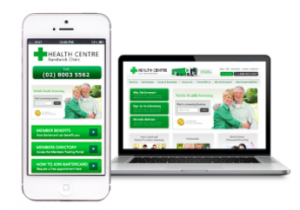Online Marketing for Healthcare Practices – Why You MUST Have a Strategy

Every marketing strategy, including all of the elements of Internet marketing and online presence, needs to be organized around goals and opportunities for your specific practice.
Although it’s a little hard to believe as we near the second decade of the 21st Century, most healthcare practices don’t actually have a strategy or defined, measurable goals for the time, energy and cost that they dedicate to various forms of online marketing.
Internet marketing is a very in-depth and high-priority communications and influence channel for healthcare practices, so it would be a mistake to try to cover every related topic in a single article. Because of the prominence and potential for effective Internet marketing, there are almost too many options for practices to consider, much less implement well.
For this reason, we will publish a series of articles pertaining to online marketing for healthcare practices. This article is an overview of online strategy and tactics.
If you don’t have a smart strategy, you will waste most of your time, money and effort to get what you want from Internet marketing.
What Do You Want from Your Internet Marketing?
 This question seems like the logical place to start crafting your strategy but many practices have only a general goal (such as get more new patients) or perhaps no goal at all other than being “in the game” because they think they are supposed to and they fear losing out to their competitors.
This question seems like the logical place to start crafting your strategy but many practices have only a general goal (such as get more new patients) or perhaps no goal at all other than being “in the game” because they think they are supposed to and they fear losing out to their competitors.
Different practices may want different things from their online marketing and presence. Start by examining which and how many of these objectives are important to your overall growth and success goals.
- More new patients
- More demand for specific services, procedures or products (business mix)
- Great patient retention, less attrition
- Increased physician referrals, less attrition
- Improve online “reputation”
- Market employee wellness programs
- Other _________________
Next, assuming you have more than one objective from this list, rank your objectives in order of highest importance to you. Then ask yourself why you ranked your priorities they way you did.
You should always challenge your instinctive priorities. You may find that you decide to re-rank your priorities differently.
Target Audiences for Your Online Marketing
 New Patients
New Patients
- Connecting with and attracting to your practice services
- Established (returning) patients
- Patient retention
- Patient endorsements (online review sites, written and video testimonials, etc.)
- Patient education
- Patient communication (patient portal, health records, appointment reminders and confirmations)
- Referring physicians
- Email correspondence
- Secure online reporting on patient encounters and treatments
- Referring Physicians and staff education pertaining to your expertise and scope of practice, when and how to refer
- Local employers
- Emails to employers
- Emails to employees
- Employer intranet
- Emails
- Texts from employer to employees
- Policies
- Alerts
- Practice staff
- Policies/HR
- Internal promotion
- Staff e-newsletters
- Announcements
Build and Strengthen Your Online Marketing In Order of Your Priorities
If you try to implement all of your Internet marketing priorities simultaneously, there is a good chance you will fall short of your goals. Your online strategy is never-ending so you don’t have to tackle everything at the same time.
It’s OK to give yourself permission to focus on one component of your Internet marketing strategy at a time. It’s often a less overwhelming and more successful approach. That’s the purpose of setting priorities.
If you are really determined to do as much as possible in the shortest period of time, you will need to assemble multiple project leaders and/or resource experts outside of your practice.
You also need to be prepared to assign responsibility to someone to oversee the overall online strategy. And you need to be prepared to pay for this extra level of expertise and support.
Do You Have a Marketing Website or Just a Pretty, Online Brochure?
Most healthcare practice websites are not marketing sites. There are many ways to create a visually attractive website but a pretty website doesn’t mean you have a marketing tool that supports your practice growth and retention strategy.
If you don’t have a strong, marketing website, you’ll come up short on most, if not all online marketing strategies you implement.

What Characteristics Are Present in Marketing Websites?
Use the list below as your checklist and then review your site to determine how many are included in your website and how well you have executed them. If you are developing a new website, make sure it has all of these elements.
I won’t get into all the geeky details here. Hire a smart geek to help with that. Try to find one who understands marketing, not just web development.
- Mobile-First Responsive Design
Since January of 2015, smartphone web traffic has increased 68%. At the same time, desktop and tablet saw a decline. Going into 2018, current estimates are that close to 60% of all searches were done on smartphones and that number will continue to rise every year for the foreseeable future.
Yet, despite these statistics, many healthcare practices and many of their web designers and developers still create the design of the site for desktop view first and then try to optimize for mobile. Doesn’t make much sense, does it?
If you start with mobile-first design, you achieve better “translation” to other devices and you also rank higher on search results.
Additionally, you come across more effectively for the roughly 60% of people who will check out your site on their smartphone.
What Defines Mobile-First?
- Content-driven (not images-driven)
- Designed for the smallest viewing screen first and then scaled up to larger sizes – not the other way around
- Designed for easy finger-scrolling
- Fast-loading (no more than 2 seconds, preferably less)
- No large images that slow loading time – images size-optimized for mobile
- Few or no pop-ups
- No Flash – use HTML-5 or Java instead
- Content optimized for search
All of your content should be written and optimized for search. The content on each page of the site also needs to be relevant to what the visitor is looking for and expecting to find on that page.
Most writers (including the good ones) cannot write content for websites that is both compelling to the live visitor and well-optimized for the search engines. This kind of writing is as much craft as art. Identify someone with relevant experience writing content that accomplishes both requirements. Ideally, the writer should have experience writing healthcare websites.
- Emotional content that inspires and motivates in addition to informing the reader
This is what is meant by “compelling” content. The content must not only be relevant to the information your visitors need but must also engage and interest them – QUICKLY – and hold their attention by increasing their emotional mind, not just their logical mind.
- Intention for every page
Begin with the end in mind for each page. What do you want the reader to understand, remember, engage with (emotionally)? What specific action do you want them to take as a result of visiting each page?
- Call-to-Action on every page (including appropriate offers)
Tell the visitor specifically what action they should take next. Make a phone call? Fill out a form to download content? Fill out a contact form? Read another directly relevant page? Buy a product through your shopping cart (if applicable)?
- Compelling well-optimized videos
Videos are (or should be) engaging – emotionally as well as intellectually. Some portion of your audience will prefer a video to text and will stay on the page and site longer if they have a video viewing option related to the topic of the page.
Google owns YouTube and Facebook owns Instagram and each site has about a bazillion visitors every day to whom you can market specific video content based on the audience’s interests and needs.
Just make sure you know or hire someone who knows how to optimize your videos for search. And make sure the video is also optimized for smartphone viewing, which means fast loading speed.
- Social sharing features
Pages should be easy and inviting for visitors to share on their social platforms – particularly blog pages, videos and podcasts.
- Easy to update and manage
Good websites are never “done.” You always need to add new, relevant and engaging content to maintain higher search rankings and inspire repeat site visitors.
This means your website should be created to be easy to quickly update and manage. This does not necessarily mean you have to be the one responsible for updating and managing.
Online Marketing for New Patients
 Potential new patients who may be looking for and/or receptive to your value fall into two primary categories:
Potential new patients who may be looking for and/or receptive to your value fall into two primary categories:
People who are actively researching and looking for healthcare providers online through searches (Google, ZocDoc, doctor review sites, provider lists and links through their health insurance carrier, etc.);
People online who are not currently looking for your services but could be receptive to your messages.
Clearly, the first category is comprised of prospective patients who are the most motivated to take immediate action. They have a reason for searching for information now.
Your job with this audience is to motivate them to choose and contact you rather than your competitors. (Why Us vs Why Now).
This category can be effectively targeted through:
- Online search advertising (Google AdWords, YouTube, etc.)
- Retargeting Ads
- Ads and predominantly positive reviews on review sites (Yelp, etc.)
- Premier listings on popular “Find a Doctor” sites (ZocDoc, etc.)
- SEO techniques to get higher organic ranking for most desired search keywords
The second category requires more education and motivational messaging to capture the attention and interest of those who are not actively searching online for what you do well but who may still be responsive to your value proposition.
This category can be effectively targeted through:
- Facebook advertising
- Instagram ads and postings
- Ads on local websites visited by people who fit your desired patient profile
- Articles on other local websites
- Other non-advertising social media targeting and marketing
Each of these online marketing methods works best when implemented by someone with deep knowledge and expertise of these techniques and how they work. You may have someone on your team who has that level of expertise, but it’s relatively uncommon to find in most healthcare practices.
There are thousands of books, articles and blogs that go into great detail on each of these areas of opportunity so we won’t attempt to provide that in-depth content in this article, however, we will publish more in-depth articles on each of these techniques in the coming weeks and months as they apply to different types of healthcare practices.
Marketing to Established Patients
 Patient retention through Internet-based communications can be positively influenced by ongoing patient education and healthy behavior reinforcement through electronic and online channels. Communication channels include:
Patient retention through Internet-based communications can be positively influenced by ongoing patient education and healthy behavior reinforcement through electronic and online channels. Communication channels include:
- Emails
- Texts
- Messages through the Patient Portal
- Social media posts
- E-newsletters
The more patients understand the factors that contribute to good or poor health, the better the chances that at least some of those patients may be motivated to make and keep regularly scheduled appointments.
These better-informed patients are more likely to be proactive in contacting the practice earlier in the development or exacerbation of the health problem.
This type of communication requires more than clinical facts and education. It requires an emotional connection to be achieved between the practice and the patient.
Positive and negative stories about patient outcomes related to the patient’s proactivity and compliance or denial and postponement of care are very effective methods to make the issue real and visceral to the patient.
Online Patient Reviews
 By now, most healthcare practices understand the impact of online reviews by patients on the reputation of the practice and decisions made by prospective patients when choosing a healthcare provider or facility.
By now, most healthcare practices understand the impact of online reviews by patients on the reputation of the practice and decisions made by prospective patients when choosing a healthcare provider or facility.
Most practices understandably feel that many of the negative online reviews they receive are unfair. It’s probably true. Now get over it. It’s going to happen whether you think it’s fair or not.
People are far more likely to share negative experiences than positive ones. So it’s inevitable that many unhappy patients will vent their frustration, disappointment, anger and resentment. Online reviews are an easy and increasingly familiar way for unhappy patients to complain and damage your reputation.
The primary strategies for limiting the impact of negative patient reviews include:
- First and foremost, you have to earn positive reviews and limit negative reviews through a practice-wide commitment to creating positive patient experiences every day. Clearly easier said than done.
Inherently, many patients are going to be unhappy when they visit a healthcare provider. They don’t feel good – physically, emotionally or both.
While you can’t always resolve the patient’s physical and/or emotional pain during a visit, you can show them that you care. You can listen to them and make them feel heard. You can empathize (sincerely) and you can provide emotional support.
If you are thinking that you don’t have time to have these types of interactions during a short patient encounter, remember that it’s the quality of the time you spend with each patient – not the quantity of time. If you are focused, you can convey caring and empathy even in a brief encounter.
The same applies to clinical and administrative staff in their encounters with patients. The personnel of healthcare practices often can’t help but become inured to the emotional state of their patients.
This can result from an unconscious need for emotional self-protection in dealing every day with people who don’t necessarily feel good and often feel bad. It’s also easy to feel too busy to really pay attention to what patients are communicating and feeling.
If the practice leaders are not committed by example to creating a consistently caring environment for the patient, you are earning your negative reviews when you could be earning more positive reviews.
- You should actually invite feedback from patients at the end of each encounter – positive or negative.
Most people don’t complain directly to you about their experience because most people are non-confrontational.
Instead, they will often exhibit passive-aggressive behavior by not voicing a complaint or frustration directly, but then later posting a review of their negative experience online for everyone to see.
Even though it’s counterintuitive, if you invite the airing of grievances at the time of the encounter, you can potentially resolve – or at least mitigate – the issue for the patient, thereby heading off a negative online review. Again, people want to be heard, particularly when they are unhappy or frustrated.
- Respond to online reviews empathetically, not defensively.
It’s natural to try to counter an unfair negative review by defending yourself but defensiveness, particularly in responding to online reviews, only makes you look petty or disingenuous or uncaring. You are actually reinforcing the negative review when you respond this way.
Instead, invite the reviewer to contact you so that you can do your best to resolve their complaint. If the reviewer identifies him- or herself in the review, reach out to them privately as well to try to resolve the complaint.
You can’t remove a negative review about your practice from a review site, but the patient can delete their own review from Google, Yelp, and other review sites.
If you successfully resolve the complaint, ask the patient if they would be willing to remove the negative review. If they agree, send them an email with step-by-step instructions on how to remove their review. You can find these instructions online by Googling “how to delete a review I wrote on (Google, Yelp, etc.).”
- Encourage happy patients to post positive reviews about their experience.
While unhappy patients don’t need to be encouraged to post a negative review, happy patients don’t necessarily think about posting a positive review of their experience.
Again, assuming you have earned the right to ask a patient to post a positive review, make the process easy for them.
There are any number of companies that provide automated contacts to patients after encounters to solicit feedback (usually via text or email), routing negative reviews back to the practice for proactive response and making it easy for happy patients to post a positive review.
Note: Yelp has the most aggressive and explicit policy against encouraging (soliciting) customers for positive reviews, but it is unclear how they police this policy.
Patient Testimonials (written and video)
 Patient testimonials are powerful influencers. Besides review sites, many healthcare practices feature written patient testimonials on their website and in social media.
Patient testimonials are powerful influencers. Besides review sites, many healthcare practices feature written patient testimonials on their website and in social media.
Some of the more sophisticated practices also create and post video testimonials from patients. Video testimonials – particularly the emotional ones – are far more powerful than written testimonials, but many patients are not comfortable on camera.
While it’s relatively easy to use a smartphone or tablet camera to record these video testimonials from willing patients, some practices opt for professional video production that takes lighting, sound, and videography to a higher level.
Regardless of how you record these video testimonials, the most important consideration is how the patient comes across in the video.
For that reason, selecting those happy patients who are best suited for video testimonials and who have compelling (and often emotional) stories to share should be the primary method of producing powerful video testimonials.
Stay Tuned
In the next article (coming soon), we will cover the topics of online communications with referring physicians, with employers and with internal staff.
In the meantime, I invite your comments. Also, feel free to call 800-924-5447 or email Lonnie.Hirsch@HirschHealthConsulting.com with questions.



Leave A Comment
You must be logged in to post a comment.